We spent the night sleeping fitfully on the deck of the Olympic Champion, and docked at Iraklion at dawn. The first bus to Knossos would not depart for a while, so we spent the early morning walking in the center of the city, which still has its Venetian wall intact. Ottoman rule seems to have left little architectural influence on the city, but the centuries of Italian rule clearly did. There was also a nice early Byzantine church. Over the centuries, it had been converted to a mosque, then to a Catholic church, then restored to the Orthodox rite. Very simple in plan, it quite nicely preserves the origins of the Christian church in the Roman municipal office building (basilica).
Iraklion shows none of the signs of poverty we saw in Athens. Every building is freshly painted or plastered, there are no desperate looking junkies or shabby looking people lounging around. I did see a few of the South Asian street sellers peddling pathetic toys, like the ones in Athens. I questioned one in broken Hindi, hoping to get some insight into the system — for the toys are everywhere exactly the same, and clearly organized by some central syndicate that puts these fellows on the street and promises some small commission to them. I have never seen anyone actually buy one of these toys, and the ones I saw in Athens looked were scrawny, hopeless-looking guys. But this fellow looked fairly cheerful, and was well enough dressed. He was a Panjabi, in his early twenties. He didn’t desperately press his wares on me. We could not converse on a level that could give me precise information. He was Muslim, and brightened considerably when I gave him a parting aleykum a‑salaam.
Our main business was to get to Knossos, which for me has been the dream of a lifetime. The bus took us directly to the gate of the site, forty minute before opening time. There were already some French tourists waiting, and shortly a tour-bus-load of Japanese turned up. Knossos is a major tourist attraction, so I had no illusions about seeing a pristine archaeological site. From the very beginning of Arthur Evans’ excavations, the site was manipulated to provide a display for tourists and an “educational experience.” That was the purpose of the “restorations” using modern materials that would horrify any archaeologist today. But the reconstructions were done with the best knowledge and guesses of the time, and there’s no doubt that they stimulated interest in and appreciation for Minoan civilization. I wouldn’t be here if I hadn’t seen pictures of the reconstructed murals as a child. How many people have a mental image of the contemporary civilization of the Hittites? There was no showman like Evans excavating Boğazkale.
I will not bore the ready with details of my tour of the ruins. I spent a long time, examining and photographing every corner of the site, most of which would appear to be uninteresting jumbles of walls and stairs. Only long familiarity with the site plan makes them intelligible. The crowds, which steadily increased over the morning, did not bother me, as they were clustered around tour guides, and I was much more interested in peripheral, unreconstructed parts of the site, such as the enigmatic circular pits which puzzle the Minoanists, but look an awful lot like Native American kivas to me.
I have my owned preferences about interpreting Knossos, but until now they’ve been based on photographs, written descriptions, and site plans. These second-hand things give little feeling for the three-dimensional reality. It was only after examining every corner of the real site that I could confidentially feel confirmed in my own interpretations. I am convinced that the “palace” of Knossos was no palace. The Minoan state of Knossos may or may not have had kings, but if they did, this complex was not an expression of it. It is nothing like the royal palaces of Mesopotamia.
The most discussed part of the complex is the Central Plaza, which Evans visualized as a palace courtyard, and the venue for the bull-leaping portrayed in Minoan art. The plaza seems singularly impractical for such an activity, but it is not impossible. Whatever ceremonies were performed there, it seems to me unlikely that they were primarily for the entertainment of a king, queen and court. Communal feasting seems more likely. Perhaps the bull-leaping was done elsewhere, and the bull brought to the plaza for sacrifice. Large quantities of cups have been found, to delicate for normal use, and there are other signs of large-scale cooking.
The most important alternative explanation of the primary purpose of the complex has been that it might have been a monastic complex. There are striking analogies in its layout to monastic complexes in Tibet (which also focus on a rectangular plaza), or the medieval European monasteries (which also had extensive storage and workshop facilities). I think this is closer to the truth, but I would take the argument a step further. At one point, I turned to Filip and said: “This is an Agora.”
Everything about the place says “Agora” to me. In my mind’s eye, I can see a market place (gr. agora), springing up between two or small sacred places that have turned into sanctuaries and places of pilgrimage. These gradually evolved into shrines served by priestesses, and eventually into a complex o monastic institutions, but always maintaining the central open space for a mixture of commercial, ritual, judicial, and political use. There is no single overwhelming sacred place, as with a Cathedral or a Mesopotamian temple. There is no single central audience hall where a king could overawe his subjects. The structure which Evans imagined to be a royal throne room is completely inappropriate for such use. It’s a small room, with a small chair set against the longest wall, at floor level. The “throne” faces a narrow space partly filled with some kind of offering bowl. Nobody ever built throne rooms like that. The aesthetic is overwhelmingly intimate and religious, not monarchical. No king who could command the impressive resources of so wealthy a state would be content with such a dinky little room, in which he could impress no one. All over the complex, there are no murals conveying kingly power and authority, nothing saying “look on this, ye mighty, and despair.” There are only pictures of flowers, children playing games, dolphins leaping in the sea, farmers harvesting their crops, athletes, elegant ladies, pets, and so on. The architectural features are everywhere consistent with domestic, commercial, and small-scale religions uses.
At some points in time, the whole complex seems to have been consolidated or rebuilt by a uniform plan, but that is quite possible in a non-monarchical context. The Agora of Athens underwent such a process under democratic rule.
Which brings us to the intriguing possibility that Knossos, and the other Minoan cities such as Malia, Phaestos, and Gortyn might have been republics of some kind, or had representative institutions coexisting with aristocracy or monarchy. Of course, no proof exists for such a hypothesis, but no proof exists for Evan’s royalist interpretation, or subsequent priestly theories. The level of evidence simply does not permit any certainties. Only the possibility of deciphering the Linear A or the hieroglyphic texts holds any hope for that. But I think that a republican interpretation has been resisted by archaeologists and historians under the influence of dubious assumptions about linear social evolution.
The emergence of republican state institutions in the 18th and 19th centuries was partly inspired and harked back to Medieval and Renaissance republics, though the continuity between them was slim stuff, and largely dependent on folkloric institutions below the state level. The Medieval republics similarly harked back to the Classical republics of Greece and Rome, though again the continuity was ephemeral. It may be that the Democracy that emerged in the Greek polis of the fourth century BC was itself harking back to remote precedents in the Bronze Age.
Before coming here, I had no clear notion of the broader physical setting of Knossos. The “palace” was surrounded by a large (by Bronze Age standards) city, of which we know very little. There were some large outlying structure, and probably a network of villages subservient to, or integrated with the city. There were roads which led directly to the central plaza — another feature that suggests an Agora. It’s only when you stand in them that you grasp that they were as technically advanced as anything the Romans built. The plaza is aligned with the region’s most dramatic looking mountain peak. It is in a valley of fabulous agricultural potential. The surrounding hills are terraced, and from what I gather the terraces, constantly rebuilt, were there in Minoan times. This valley in turn was part of a system of broad, fertile valleys and plains that dissects the island of Crete, with other major Minoan sites scattered in it. This area is extraordinarily beautiful. The Neolithic agricultural “package” of domestic animals and crops would have supported a very high standard of living, and combined with fishing and sea trade would have made life very sweet by ancient standards. The murals don’t seem to lie.
We returned to Iraklion and visited its Archaeological Museum. This was almost as great a pleasure as Knossos itself. It contains most of the famous artifacts unearthed at Knossos. It’s only when you see them in real life that you can fully appreciate them. Some are of great beauty. Some are just delightful, like the toy or model house, which is so detailed and obviously intended to be realistic that we can confidently picture what Minoan houses actually looked like. The famous murals are there. You can imagine my delight at being photographed in front of the “Prince of the Lilies” mural that adorned my website for years.
Now we were ready for the more physically demanding part of the journey. It’s important to me to visit a minor, unexploited Minoan site to make sure that my opinions are not distorted by the atypical status of Knossos. I selected a small site in Eastern Crete, which has the advantage of being near another archaeological site dated from the turbulent Post-Minoan times. This involves mountains and crossing rough country on foot. The loss of Filip’s papers means we can’t do any driving. So, it’s buses and feet, and night under the open sky.
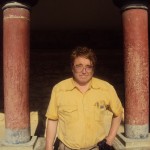
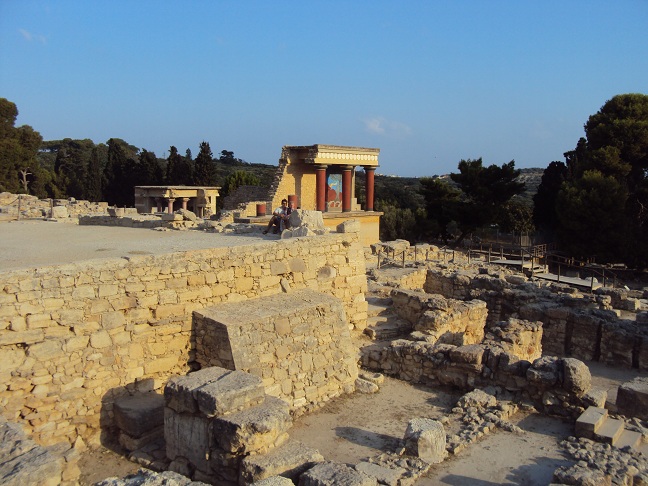
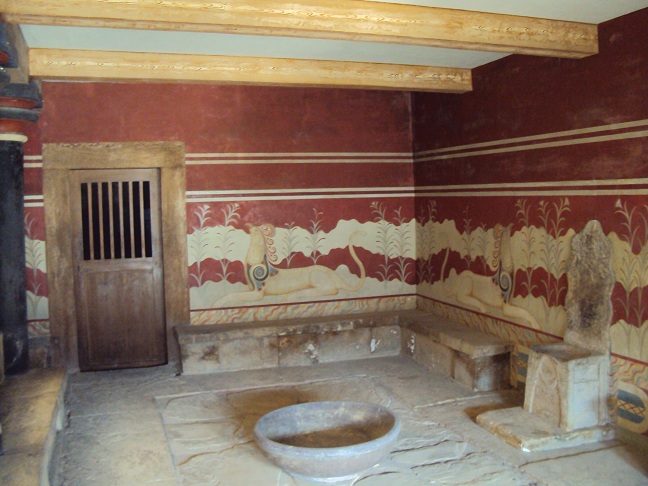
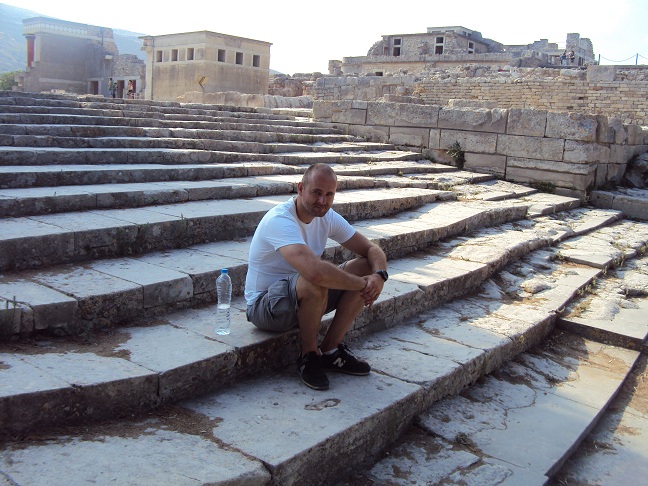
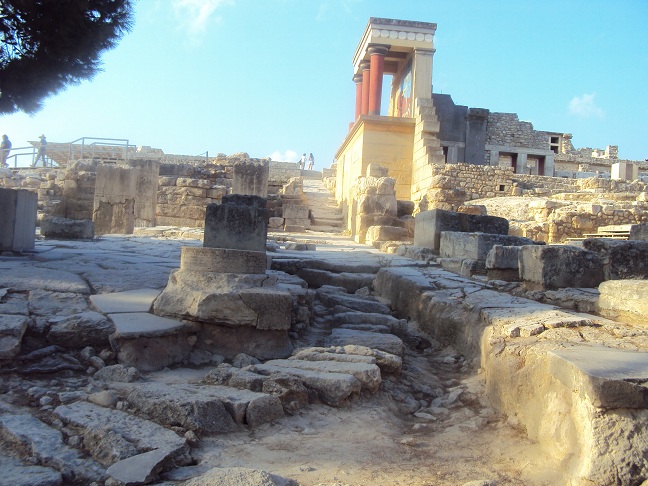
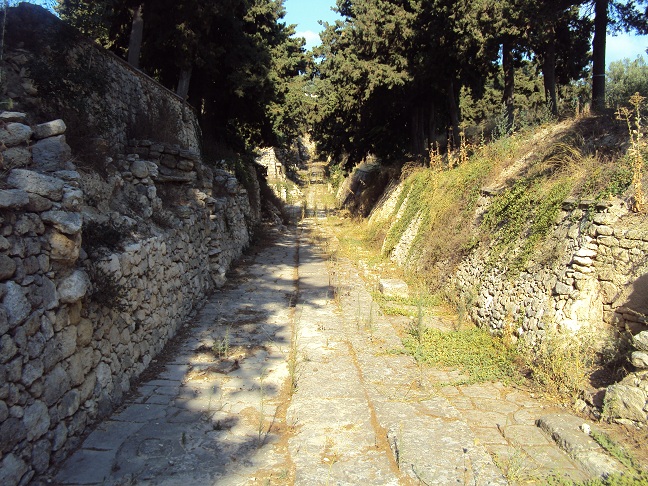
0 Comments.